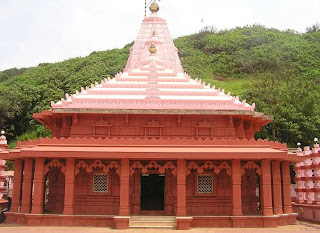Raigad (Marathi:रायगड) is a hill fortress situated in the modern day Raigad district of Maharashtra, India. The Maratha king Shivaji Maharaj made the fort his capital in 1674 when he was crowned King of a Maratha Kingdom which later developed into the Maratha Empire eventually covering majority of modern day India. It was the capital of King Chhatrapati Shivaji Maharaj because according to him the fort was so terrifying & difficult as no blade of grass grows on completely vertical rock. British has also defined the fort Raigad as ‘The Gibraltar of East'.
"Fort Raigad is much more than a mere tourist spot. It is a sacred place of pilgrimage, which has left an imprint of the grand vision of Hindavi Swarajya as cherished by Chhatrapati Shivaji Maharaj."
Trekking: There are many interesting routes to Raigad, varying from the relatively easyto the challenging. The path starts from Pachad, 24 kms from Mahad, a shallowseaport on the banks of the Savitri River. Raigad can also be anadventure-filled day excursion from the hill station of Mahabaleshwar or fromPune.
At the foothills near village Pachad, is Chit Darwaja, also known as Jit Darwaja. After gruelling foot-slogging, you reach Khoob Ladha Buruj. It is a strategically located turret, from where an aggressor attacking from either flank could be repelled. Nearly a mile ahead, after a difficult climb comes the Maha Darwaja. Built over 350 years ago, this main entrance to the Fort stands majestically. It is as imposing and stout today, as it was then! The design of this Maha Darwaja is an enigma. It defies detection of its location to the attacker. Blind curves enroute make it impossible for the attacker to use elephants to knock it down. In the battle of those historic times, elephants were used to demolish fort entrances.
A steep climb of nearly 1450 steps and three and a half hours of extreme demands on your physical stamina, leaves you too exhausted. The magic mantra - Raigad Ropeway - has opened a new chapter of sightseeing - the Fort Raigad. It whisks you to the top, through the clouds and whistling winds, in just 4 minutes. Gone is its exhausting inaccessibility. Now you have all the energy and time to enjoy the sightseeing! Well-trained and courteous guides are at hand to give you a conducted tour of the Fort.
The Ropeway lands you at the top of the fort near Mena Darwaja. This was the special entrance for the royal ladies and the queens. To the left of Mena Darwaja is the Rani Vasa or "Queens' Chambers". They are six in number and were being used by the mother of Shiv Chhatrapati - Jeeja Mata, Soyarabai, Putalabai and other royal ladies.
In front of the Rani Vasa is the Palkhi Darwaja. A special entrance for the convoy of Shivaji Maharaj. On the right side of Mena Darwaja, is the office complex of 8 principal secretaries of Shivaji Maharaj. To the right of Palkhi Darwaja, there is a row of three dark chambers. Historians believe that these were the granaries for the fort.
To the right of the granaries is the palace of Shivaji Maharaj. It is called the Raj Bhavan, where he dispensed justice in petty and routine matters. The palace rests on a double plinth and had wooden columns to support the palatial structure. The Raj Bhavan is a mute witness to the joys, sorrows, anger, victories and overwhelming generosity of Shiv Chhatrapati. The plinth adjoining Raj Bhavan, holds two large water tanks and by its side, is the location of the Royal Bath. Excellent toilet and drainage system highlights the structural design of that era. To the east of Raj Bhavan is in an open space, there is an underground cellar. It was used for secret dialogues, worshipping Bhavani Mata and for storing war booty after the raid on Surat.
The fort has many huge water reservoirs, one of which is the picturesque Ganga Sagar. Two main entrances from the Royal Palace open in to a sprawling lawn. This is the Raj Sabha. It has witnessed the splendour of the glorious coronation of Shiv Chhatrapati. The shackles of 300 years of slavery were broken and Shivaji Maharaj proclaimed establishment of Hindavi Swarajya! The magnificent throne, studded with diamonds and gold, rested on eight columns of pure gold weighing almost 1000 kilos. It also bears the royal emblem of Shivaji Maharaj. The umbrella over the throne was adorned with strings of precious stones and pearls.
Entry for common public to Raj Sabha was through the Nagarkhana. In those times, the royal band played here round the clock. It is an excellent example of architecture and miraculous acoustics. The distance between 'Nagarkhana and the Royal Throne is more than 200 feet, yet even the slightest whisper can be heard from both ends very clearly.
Holi Cha Mal, is outside the Nagarkhana. It is a wide open ground, used for annual Holi festival. There is a temple of Shirkai Bhavani, a presiding deity of the Fort. In front of Holi Cha Mal, there is a spacious and well laid-out marketplace. It is built on a high plinth and is separated by a 40-foot wide road leading to the Jagadishwar Temple. Adjacent to this temple, is the most revered place on Fort Raigad, the Samadhi of Shiv Chhatrapati. The Samadhi is intact and well-maintained, even today, due to the personal initiative of Lokmanya Bal Gangadhar Tilak.
Other places of interest are ammunition depot, Bara Tanki i.e. more than a dozen huge water reservoirs, Rameshwar Mandir, Wagh Darwaja, Takmak Tok - an execution place for the proclaimed criminals, etc. These are testimony to the valour, courage and ultimate sacrifice of Maratha soldiers, who made Hindavi Swarajya a reality.














0 comments: